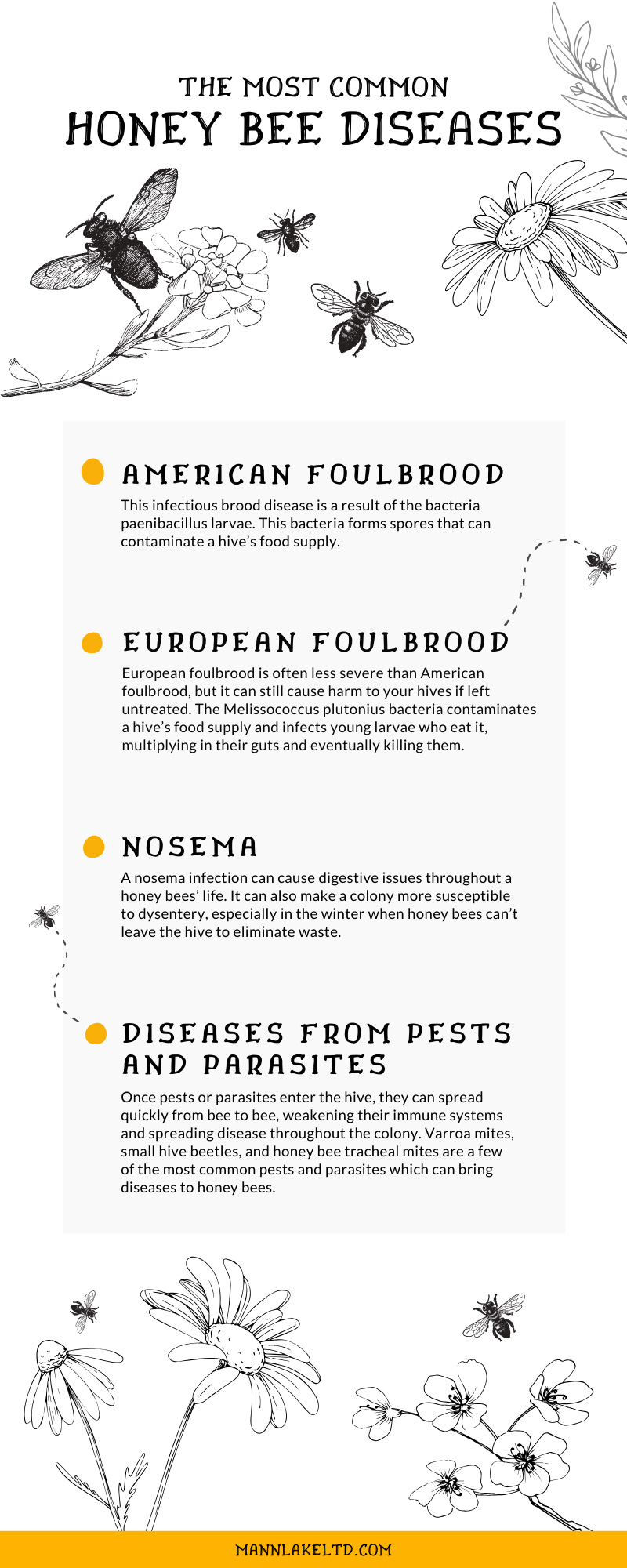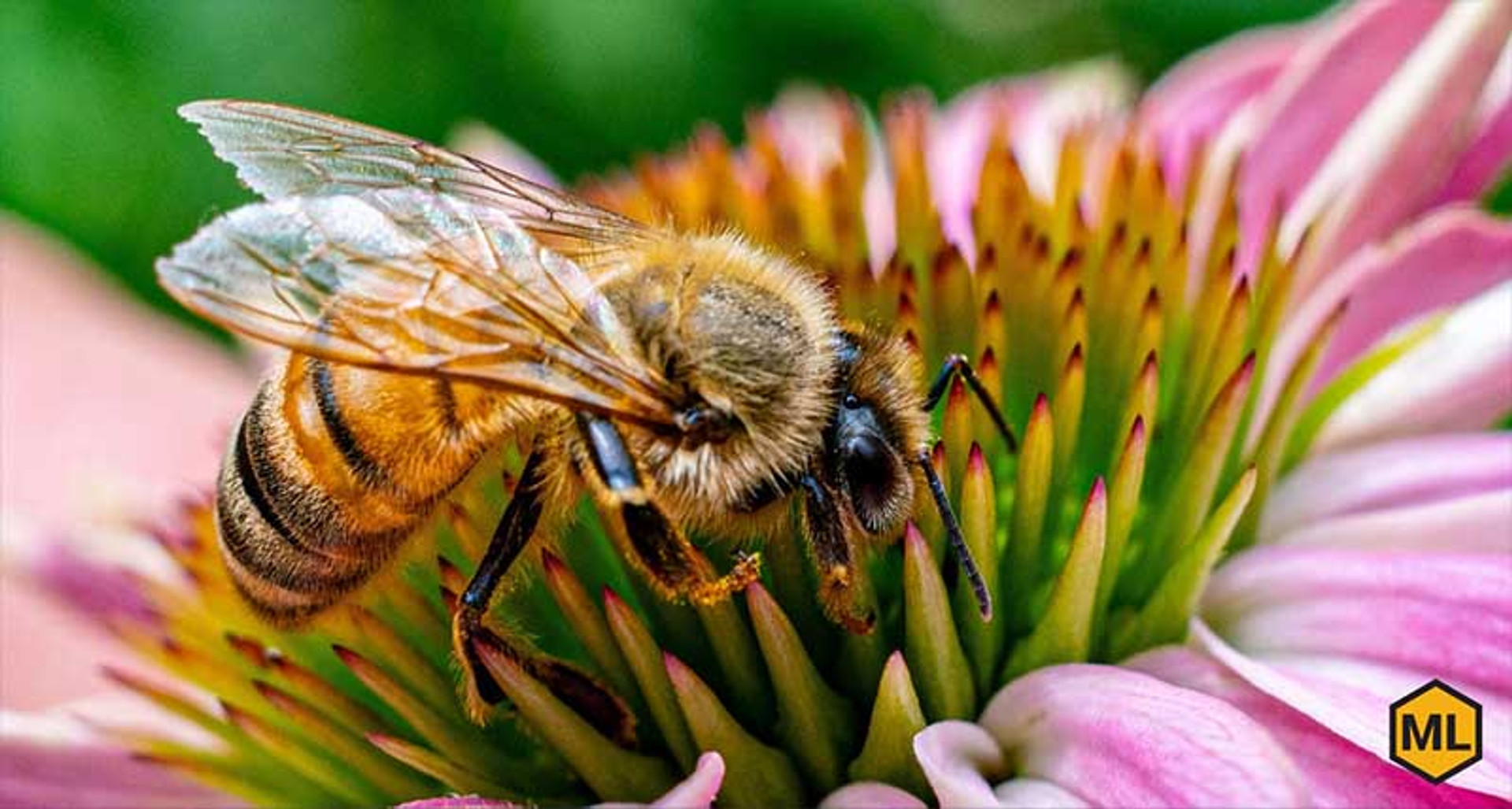The Most Common Honey Bee Diseases
Like all animals, honey bees often face viruses and other diseases that threaten their health and safety. Unfortunately, the close quarters and constant interaction of a honey bee hive means that diseases can spread quickly through the colony and cause serious damage.
The trick to keeping your honey bees safe from such a fate is knowing the telltale signs and symptoms of these hazardous diseases. When you can quickly and accurately identify an issue, you can address it and set your hives back on the path to success.
To help you keep your colonies thriving for years to come, here’s our guide on the most common bee diseases and other health issues.
American Foulbrood
This infectious brood disease is a result of the bacteria Paenibacillus larvae. This bacteria forms spores that can contaminate a hive’s food supply. When the honey bee larvae eat this food, the bacteria multiply within their stomach and quickly kill them.
The bacteria will then form more spores within the larvae’s cells. American foulbrood only affects young larvae. However, when adult bees come and clean out the dead larvae’s cells, they spread the spores of the bacteria further into their food supply, letting the problem grow.
European Foulbrood
While European foulbrood is often less severe than American foulbrood, it can still cause harm to your hives if left untreated. This disease works in a similar way to American foulbrood.
The Melissococcus plutonius bacteria contaminates a hive’s food supply and infects young larvae who eat it, multiplying in their guts and eventually killing them. Unlike American foulbrood, European foulbrood doesn’t form spores.
However, it can remain on spores, beekeeping equipment, and other infected surfaces for a long time, even withstanding winter and other harsh conditions. You can purchase test kits and other treatment options for both brood diseases.
Nosema
Nosema disease or nosemosis occurs when Nosema apis, a spore-forming unicellular parasite, infects a hive’s food or water supply. Adult honey bees will then ingest these spores, which germinate and multiply within the lining of the bees’ gut.
A nosema infection can cause digestive issues throughout a honey bee’s life. It can also make honey bee colonies more susceptible to dysentery, especially in the winter when honey bees can’t leave the hive to eliminate waste.
In these scenarios, the spore-infected waste remains in the hive, adding to the spread of the disease. You can use the antibiotic Fumidil to treat nosema disease in your hives.
Diseases from Pests and Parasites
Some of the most common bee diseases come from pests, parasites, and other creatures that invade the hive. The warmth, shelter, and free food source within a honey bee hive make it a prime target for such intruders.
Honey bees work hard to keep their hives clean, deterring many of these pests. Unfortunately, these cleaning habits aren’t always enough to keep mites, beetles, and other critters at bay. Once pests or parasites enter the hive, they can spread quickly from bee to bee, weakening their immune systems and spreading disease throughout the colony.
Here are a few of the most common diseases honey bees can get from pests and parasitic mites.
Varroa Mites

Many beekeepers consider Varroa mites to be one of the biggest threats their honey bees face. These tiny, circular mites affect both adult honey bees and their brood. A Varroa mite will rest on the back of a honey bee and feed on its bodily fluids.
Female mites will also sneak from a worker bee’s body into brood cells. From there, they feed on the brood food, reproduce, and eventually infect the newly hatched honey bee.
During spring and summer, when a hive is most productive, Varroa mite populations can double every four weeks. This poses a serious threat for many reasons. These mites can weaken the honey bees’ immune systems, leaving them more susceptible to diseases.
At the same time, they commonly carry many viruses, such as deformed wing virus or acute bee paralysis virus, and can infect a hive with them. Because these mites feed on the bees’ blood, they transmit these diseases directly into the bloodstream, making even mild diseases extremely dangerous.
Fortunately, there are a few Varroa mite treatment options that can help you eliminate an infestation. You can also install a screened bottom board in your hive. When your worker bees groom themselves after a flight, any mites they dislodge will fall through the screen instead of staying inside the hive.
Small Hive Beetles
These beetles are another common pest that your honey bees face. The adult beetles are black or brown and grow to be about a third of the size of a honey bee. However, it is the larvae that do the most damage to a hive.
Hive beetle larvae feed on the honey and pollen within a hive, destroying a colony’s food supply. As they go, the larvae’s feces cause the remaining honey to ferment and froth, making it unsuitable for the honey bees.
In severe cases, the destruction of food sources can cause a colony to completely abandon its hive. Some research even states that small hive beetles are a possible factor in colony collapse disorder. You can use traps, beetle blasters, and other small hive beetle treatments to protect your honey bees from a hive beetle infestation.
Honey Bee Tracheal Mite
Another parasitic mite that can bring devastation to your colony is the honey bee tracheal mite. These mites live within the thorax of a honey bee, infesting the bee’s breathing tubes or tracheae.
Tracheal mites might also reside in the air sacs within a honey bee’s thorax, abdomen, or head. From their place within the honey bee, tracheal mites can puncture breathing tube walls to reach and feed on the bee’s blood.
After feeding on a honey bee, female tracheal mites will transfer to a younger bee to lay their eggs. Tracheal mite infestations cause a honey bee to have breathing problems. Bees can also become vulnerable to pathogens on the tracheal surface.
The bees that are weak or sick because of this parasitic mite won’t be able to perform as well for the hive, leading to a less productive hive. Fortunately, there are tracheal mite treatments that can help you fight an infestation in your hives.
Prevention Strategies for Bee Diseases

Prevention is always better than cure, especially when it comes to the health of your hives. One of the best ways to prevent diseases is by maintaining cleanliness within and around your hives.
Regularly sanitizing your beekeeping equipment and replacing old combs can significantly reduce the risk of introducing germs and diseases. Implementing good beekeeping practices, such as regular screening for parasites and diseases, can also be a game-changer.
If you detect these pests early on, it becomes much easier to control them. Consider feeding your bees higher-quality supplemental nutrition during periods of food shortage. A healthy diet can boost their immune system and make them less susceptible to diseases.
Sustainable Beekeeping Practices to Fight Diseases
Sustainable beekeeping goes beyond just harvesting honey. It also involves taking care of the bees and the environment they live in. Using organic methods of pest and disease control is an integral part of this.
The use of organic compounds like formic and oxalic acid can help control Varroa mite populations without exposing the bees to harmful chemicals. Instead of using artificial feeds, aim to promote a healthy foraging environment by planting pollinator-friendly plants around the hives.
Not only will this provide a diversified diet for your bees, but it will also minimize their exposure to pollen sources that might be infected.
Importance of Regular Hive Inspections
Bees are skilled at concealing problems until they become major, so closely inspecting your hives at least once a week is a good rule of thumb. Observing bee behavior, brood pattern, and the presence of the queen bee can give you a general idea about the health of your hive.
Making use of disease detection techniques can save your hives from potential health threats. For instance, detecting bee brood diseases can be done by utilizing test kits. For nosema, a microscopic examination of bee feces is usually conducted.
Alcohol wash or sugar shake methods are preferred for Varroa mites. Knowing which techniques to use and when to use them can spell the difference between a thriving colony and a sick one.
Final Thoughts on Ensuring Hive Health and Success

Preventing, managing, and treating diseases are core aspects of beekeeping. With vigilance and the right practices, you can ensure your bees stay healthy and productive all year round. As always, stay connected to local beekeeping communities and keep yourself updated with the latest research and developments in bee health management.
Mann Lake is here to help your hives stay healthy and successful. From the medication and treatment options you need to your beekeeping equipment, we’re your one-stop shop for all things honey bee.


